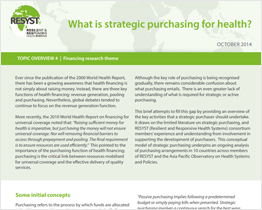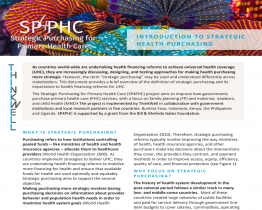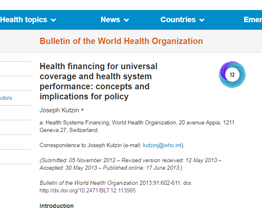How countries pay for healthcare is a critical factor in advancing universal health coverage (UHC). Health financing systems affect the availability of services, who is able to access them, and whether people can afford them. Health financing describes more than just the money available for health; it includes all of the mechanisms, from raising funds to paying for health services. A well-functioning health financing system ensures that people can access the health services they need without suffering financial hardship and that resources are used efficiently and equitably. Government tends to play a significant role in financing healthcare in most countries, although the private sector may also play an important role. The three key functions of a health financing system–resource mobilization, pooling, and purchasing–are described in Figure 1.
Figure 1. Three key health financing system functions

Resource Mobilization: Countries need to consider three issues:
-
What are the sources of funding for health? Funding can come from domestic sources (e.g., citizens and businesses within the country) and external sources (e.g., donor governments or agencies). Donor funding may include grants or concessional loans. More information on domestic resource mobilization is available on this webpage.
-
How are funds collected? Funds for healthcare can be collected through taxes, health insurance schemes, at the point of service (e.g., out-of-pocket payments), and other mechanisms.
-
Who collects the funds?Resources for health are often collected by the government or public agencies, but they may also be collected by private health insurance schemes and directly by providers.
Pooling: The objective of pooling resources for health is to make health expenditures more predictable and to protect households from paying the full cost of healthcare at the point of service delivery. Pooling helps promote equity, as those with greater ability to pay and those with less risk of getting sick subsidize poorer and higher risk individuals. In order to work, the pool needs to be large and diverse. Resources for health are typically pooled through government-funded systems that pool tax revenues and through health insurance schemes that pool contributions from enrolled individuals.
Purchasing: In a given country, the ministry of health, a social security agency, insurance providers, or individuals can purchase health services. The design of purchasing mechanisms are based on the following four issues:
-
What services should be purchased? Often, governments or health insurance providers will identify a benefits package that specifies the health services they will partially or fully pay for. The design of benefits packages is typically based on the need for, effectiveness of, and cost of specific health services.
-
Who should services be purchased for?In developing countries, many individuals pay out of pocket for health services at the point of service delivery. Governments often try to reduce out-of-pocket payments by subsidizing or providing free health services for different segments of the population. For instance, the government may subsidize health services for the poor or vulnerable. Higher-income individuals may not be eligible for such subsidies but may choose to enroll in other schemes, such as private health insurance.
-
Who should services be purchased from? Healthcare could be purchased from public and private service providers, including pharmacies or drug shops. In some countries, governments may purchase services exclusively from public providers, while others may contract with private providers.
-
How should providers be paid for services? Purchasing may be “passive” or “strategic”. Passive purchasing is based on a pre-determined budget or pays for costs as they arise. Strategic purchasing deliberately structures payment mechanisms to maximize health outcomes, lower costs, and incentivize quality. There are different methods for paying providers that could incentivize the quantity and quality of services provided. Two common methods include fee-for-service, where providers are paid based on the number and types of services provided; and capitation, where providers are paid in advance based on the number of patients or population size entitled to a certain service.
Financial Incentives in Health: Demand-Side and Supply-Side Financing
Health financing systems should motivate users to seek health services they need and providers to deliver quality health services. Health financing interventions are broadly categorized into two categories–demand side and supply side–based on differences in who receives financial incentives (e.g., payments that motivate certain behavior that might not occur without the financial benefit (Figure 2)). Demand-side financing interventions provide financial incentives directly to the user (e.g.,vouchers) and supply-side financing interventions provide financial incentives to the provider (e.g., pay-for-performance). Programs may combine both supply-side and demand-side approaches to improve service access and quality. Health financing approaches to improve the supply of and demand for health services are explored elsewhere on this website.
Figure 2. Difference in Demand-Side versus Supply-Side Financing Interventions

Image adapted from Peter Berman. Building Public/Private Partnership for Health Systems Strengthening: Vouchers: An Overview. The World Bank. Presentation June 21–25, 2010, Bali, Indonesia.
Why Is Health Financing Important to Family Planning?
For countries to have sustainable family planning programs, they need to ensure that sufficient funds are mobilized for family planning. They also need to ensure that these funds are pooled to allow for cross-subsidization and that family planning services are purchased in an efficient way that motivates providers to offer a diverse range of high-quality family planning methods. Financing options for improving and sustaining family planning programs are explored in detail on this website.
Finally, family planning financing could benefit from countries undertaking broader health financing reforms toward UHC. Particularly because donor funding for health is declining, countries are looking for ways to mobilize more domestic resources so as to improve the quality and availability of health services, while also providing financial protection from out-of-pocket health expenses. These reforms offer opportunities to mobilize additional resources for family planning and to improve the efficiency of family planning spending.
Resources
This fact sheet provides an overview about the concept of strategic health purchasing and its importance in health financing reforms.
With limited domestic funding, a scale back by external donors, and ambitious health and health coverage targets, there is an urgent need to...






